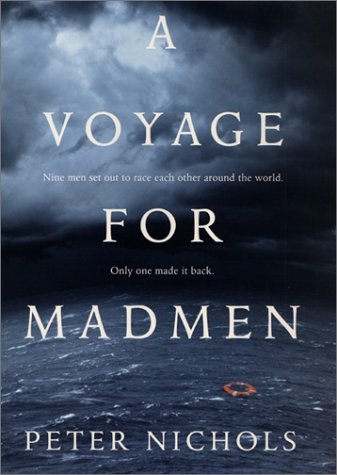
A Voyage for Madmen
by Peter Nichols
Reviewed by McCabe Coolidge
 |
Why in the world would three sailors enter an ‘around the world, singlehanded’ race in sailboats meant only for coastal cruising? Even better why would a man enter this race who never ever sailed before? Peter Nichols wrote this 289 page book driven by these questions and others just as odd. The focus of this narrative is the 1969 Golden Globe Single Handed Race around the world accompanied by personal stories of heartbreak, shipwreck and with one sailor, madness.
I once crewed on an ocean 71 from San Francisco to San Diego. She had been such a competitor in a round the world race. Well built, fast, but not luxurious compared to today’s yachts. The author launched himself into a wooden sailboat and attempted to cross the Atlantic propelled by the pain of divorce. He almost made it. His curiosity is more than that of a researcher. What causes a man to go into a long term solitude and expect to live?
Nichols has been a yacht captain, an instructor of creative writing, and is now a full-time writer. A Brit, living in Northern California, he is the author of Sea Change: Alone Cross the Atlantic in a Wooden Boat and Voyage to the North Star. His writing resembles those he is describing and their vessels. A little jumpy, primitive, extremely honest, straightforward, intensely reflective.
So what happened? One sailer out of the nine finished. Another sailor became mentally imbalanced and circled the southern Atlantic while reporting he was off the Coast of South Africa.
Even the start of the race gives readers an accurate glimpse of how disorganized the preparations were for this contest. Weeks separated their launchings; each sailor chose a different site to cast off their lines. No millionaires stepped forward to be patrons. The lack a capital severely hindered a proper equiping of these sailboats. The prize money ranging between 5,000 and 15,000 pounds was a strong motivator to sail and to finish.
Reading this book of a race just 30 or so years ago was like reading an historical account of another age of sailing. Before G.P.S., autopilots, refrigeration and e-mail. These racers had few of the comforts and securities modern cruisers and racers now take for granted. They were game if not foolhardy in some cases for even sailing out the English Channel.
Nichols also gives us the sense of the inner life of these competitors, how they lived with lonliness, alone on often unfriendly seas. The author had access to their journals as well as the interviews conducted before and after the race. For the duration of the race, no sailor could step ashore nor on the bow of another boat without being eliminated. Mail drops were literal, from a tanker thrown out and down to the little sailboat, bobbing up and down in the deep blue.
We are drawn quickly to two competitors: Robin Knox Johnson, a Brit, the winner and only finisher, and Bernard Moistessier, a Frenchman, author and mystic, who when he caught up with Johnson, instead of turning north and heading into the Atlantic Ocean toward home kept going for another circumnavigation. These two were articulate and competant sailors. I was drawn to them as they reflected on their motivation to enter the race and their insights along the way.
In 1966-1967 Francis Chichester, a 65 year old man sailed around the world alone, stopping only once. He sailed the Gypsy Moth II, a 39’ sloop. He along with Joshua Slocum, who in the years 1895-1898 first circumnavigated in a vessel named the Spray. Slocum wrote ‘Sailing Alone Around the World’ while Chichester wrote ‘Gypsy Moth Circles the World.’ Both were best-sellers and gave the impetus for the premiering of this race.
What about those of us who have never crossed an ocean let alone circled the globe? Why might we want to read this account? As I read of each new adventure I examined my motivation for sailing the oceans and whether I might want to sail alone for any extended period of time. I also enjoyed story after story, ocean after ocean, cape after cape knowing that each had a sextant, some sails, a vessel but little else. How would they survive? Nichols gives us a great tale.
This book’s strength is the intimate portrayal of the competitors; their foibles, weaknesses as well as their great courage in entering such a race and staying with it until they could sail no longer.
McCabe Coolidge currently lives in Beaufort, NC